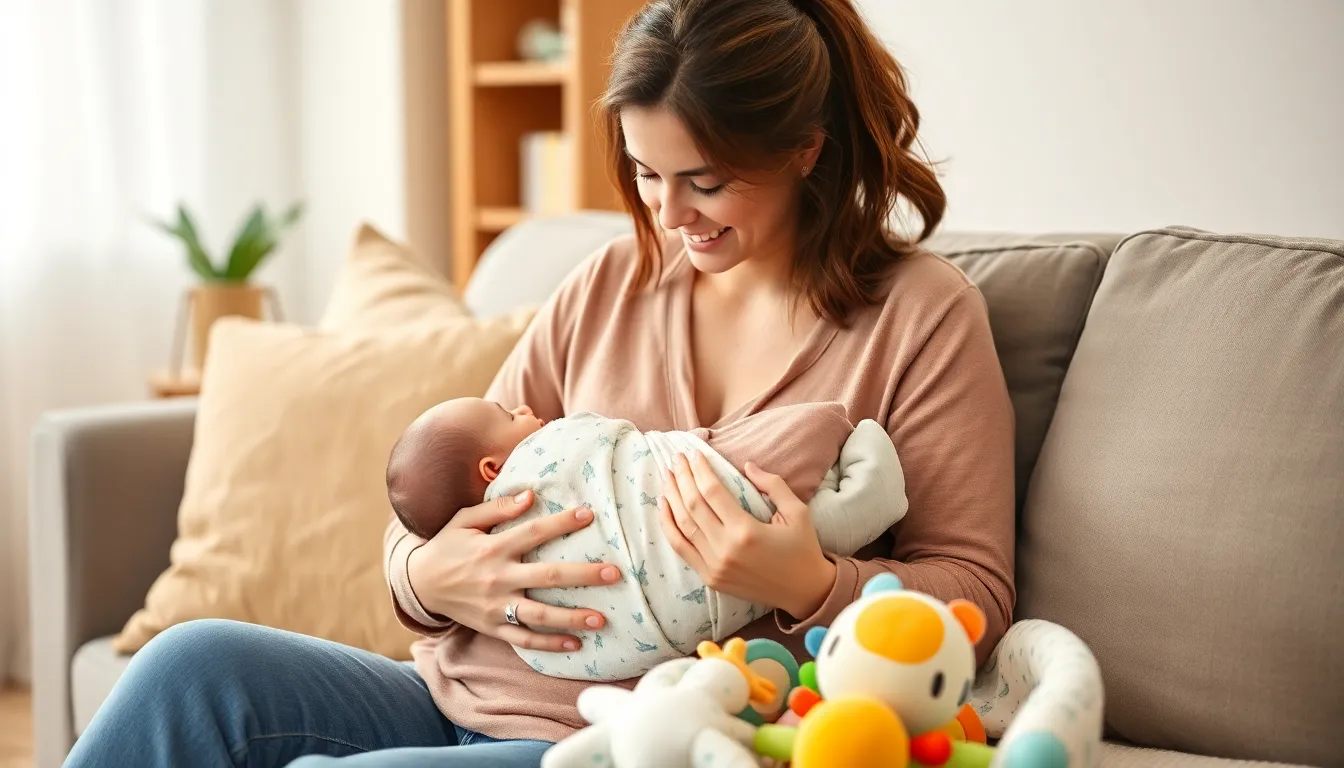When it comes to swaddling, it’s not just about keeping the little ones snug; it’s an art form that can turn a fussy baby into a serene bundle of joy. Mastering baby wrapping techniques can feel like trying to solve a Rubik’s Cube blindfolded, but fear not—this guide is here to help. With a few simple tricks up your sleeve, you’ll soon be wrapping like a pro, leaving your baby blissfully cozy and you feeling like a parenting wizard.
Imagine the satisfaction of hearing that sweet sigh of relief as you tuck in those tiny arms and legs. Not only does proper wrapping promote better sleep, but it also gives parents a chance to showcase their newfound skills. So grab your favorite fabric and get ready to dive into the world of baby wrapping—because who knew that turning a baby into a burrito could be so rewarding?
Table of Contents
ToggleOverview of Baby Wrapping Techniques
Understanding baby wrapping techniques involves several approaches, each designed to provide comfort and security. Wrapping can enhance a baby’s sense of safety, mimicking the snugness of the womb. Various methods exist for parents to explore, ensuring they find the one that suits their needs.
Swaddling remains the most popular technique. It involves securely wrapping a baby in a cloth, keeping their arms snugly positioned to prevent startle reflexes. This method promotes better sleep and reduces fussiness during nighttime.
The hip carry technique stands out as well. It allows parents to hold the baby upright against their hip, providing a comfortable position that encourages interaction. Parents can use a soft wrap or structured carrier for this method.
Additionally, the cradle carry technique offers an alternative for soothing babies. Cradling involves holding the baby horizontally in one arm, allowing for eye contact and direct bonding. This not only calms the baby but also facilitates breastfeeding.
Different types of fabrics enhance the experience of baby wrapping. Muslin, for instance, is lightweight and breathable, preventing overheating while offering stretchability. Cotton blends provide warmth and cushioning, making them suitable for colder environments.
Safety remains a priority in baby wrapping techniques. Ensuring that the wrapping isn’t too tight is crucial, as restrictions can affect the baby’s development. Using certified wraps or carriers guarantees support and safety for the baby.
Mastering various baby wrapping techniques empowers parents. Embracing these methods nurtures a stronger bond while ensuring the baby remains secure and comfortable. Exploring these options fosters confidence in baby care, enhancing the overall parenting experience.
Benefits of Baby Wrapping

Baby wrapping offers various advantages that impact the well-being of both the baby and the parent. It creates a nurturing environment for infants and fosters closeness.
Emotional Connection
Building emotional bonds is crucial for healthy development. Baby wrapping promotes skin-to-skin contact, enhancing feelings of safety and security. Wrapped babies often display less stress, leading to happier moods. Parents also benefit from this technique; wrapping encourages interaction, leading to stronger attachment. A gentle embrace reassures the baby, boosting their confidence and trust. Engaging in baby wrapping creates opportunities for shared moments between parent and child, reinforcing their emotional connection.
Physical Comfort
Physical comfort emerges as a key benefit of baby wrapping. Wrapping provides warmth, mimicking the cozy feeling of the womb. Babies wrapped securely tend to sleep longer and more soundly, reducing fussiness. The snug fit minimizes the startle reflex, which often disrupts sleep. Various wrapping techniques accommodate different preferences, allowing parents to choose what works best for their baby. Additionally, using soft, breathable fabrics ensures moisture-wicking properties, further enhancing comfort. When babies feel cozy and secure, they are more likely to thrive in their environments.
Types of Baby Wrapping Techniques
Various wrapping techniques exist, each designed to provide comfort and security for babies. Understanding these techniques can help parents choose the best fit for their little ones.
Traditional Methods
Swaddling represents one of the oldest and most recognized techniques, securely wrapping the baby in a blanket. This method mimics the womb’s snugness and effectively calms infants. The use of soft, rectangular blankets allows for versatile folding styles. Techniques like the “diamond wrap” and “sack wrap” emphasize a secure fit around the arms while leaving the legs free for movement. Parents also favor the “arms-up” style, accommodating babies who prefer some upper body freedom. Each method promotes restful sleep while reducing startle reflexes, ensuring the baby remains undisturbed.
Modern Approaches
Modern baby wrapping approaches incorporate soft carriers and wraps, emphasizing convenience and mobility. Soft structured carriers support ergonomic positions for both the baby and the parent. These carriers often come with adjustable straps that provide a customizable fit, enhancing comfort. Wraps made from stretchy fabric allow for easy tying and repositioning, catering to the parent’s needs during outings. Hip carries serve as a contemporary choice, enabling parents to interact with their babies while keeping them secure and upright. These techniques not only promote bonding but also provide an opportunity for parents to remain hands-free while parenting.
Safety Considerations
Safety considerations are paramount when wrapping a baby. Proper techniques and materials ensure a secure, comfortable experience.
Proper Positioning
Positioning the baby correctly prevents potential issues. Always place the baby on their back to sleep, promoting safe sleep practices. Wrapping should allow for leg movement, enabling natural hip development. The baby’s arms can remain in or out of the wrap, depending on individual comfort. Ensure the wrap isn’t overly tight around the chest, allowing for free breathing. Checking for any signs of discomfort or restricted movement is crucial during and after wrapping.
Material Selection
Selecting the right materials enhances comfort and safety. Choose breathable fabrics like muslin or cotton to maintain proper airflow. Soft materials reduce the risk of irritation on delicate skin. Avoid heavy or non-breathable fabrics that could cause overheating. Additionally, any fabric should be free from harmful dyes or chemicals. Regularly inspecting for wear or damage ensures continued safety during use.
Embracing baby wrapping techniques can significantly enhance the parenting experience. The right methods provide comfort and security for babies while fostering emotional connections. Parents can enjoy the benefits of better sleep for their little ones and increased interaction during the day.
With a variety of techniques available, from traditional swaddling to modern carriers, there’s a perfect fit for every family’s needs. Prioritizing safety and comfort ensures that both baby and parent thrive in this nurturing practice. Mastering these skills not only empowers parents but also creates a cozy environment that promotes happiness and well-being for the entire family.




